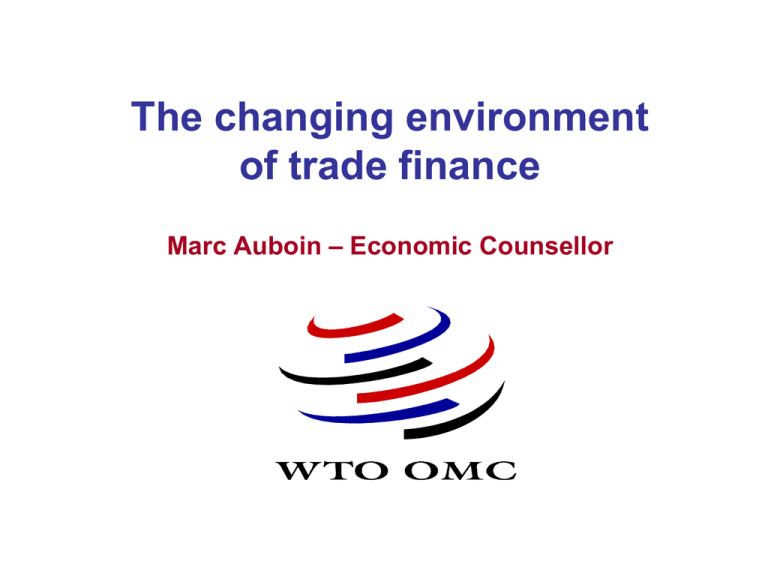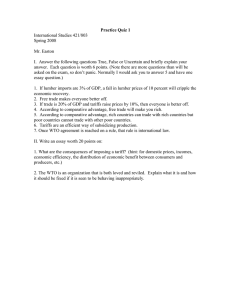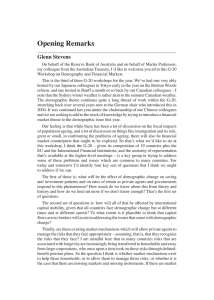The changing environment of trade finance – Economic Counsellor Marc Auboin
advertisement

The changing environment of trade finance Marc Auboin – Economic Counsellor Trade and trade finance during recent cycle • Trade: multiplier of the global crisis but also multiplier of the global recovey. Trade more cyclical than GDP because high manufacturing content. Demand for intermediate products and durables fell more than the rest but also rebounded more than the rest. • During the recent period of crisis, demand affected production globally through the international division of labour and contraction of inventories + lack of trade finance. Open economies more affected and others. The fall of Asian exports was for 6 months larger than that of developed countries. Decoupling theory wrong. Recovery process symmetric Quarterly world merchandise exports by region, 2007Q1 - 2010Q4 a (y-o-y percentage change) 80 60 World b 40 North America c 20 South and Central America Europe 0 Commonwealth of Independent States -20 Asia b -40 Others d 2010Q4 2010Q3 2010Q2 2010Q1 2009Q4 2009Q3 2009Q2 2009Q1 2008Q4 2008Q3 2008Q2 2008Q1 2007Q4 2007Q3 2007Q2 2007Q1 -60 a Not seasonally adjusted b includes significant re-exports or imports for re-exports c includes Mexico d includes Africa and Middle East. These regional totals are significantly under-represented. Note: Quarterly figures may not add up to total figures published elsewhere in WTO's statistical publications or online databases. Sources: IMF, International Financial Statistics; Eurostat, Comext Database; National statistics; Global Trade Atlas. Chart 1: Growth in volume of world merchandise trade and GDP, 2000-11 a Annual % change 15 Average export growth 1990-2008 10 5 0 Average GDP growth 1990-2008 -5 Merchandise exports -10 GDP -15 2000 2001 2002 2003 2004 a Figures for 2011 are projections. Source: WTO Secretariat. 2005 2006 2007 2008 2009 2010 2011 a What is traded globally? WTO Stats. 100 18.1 90 WTO Secretariat 31.7 80 70 7.9 3.1 4.3 3.7 10.6 4.8 18.2 7.2 3.2 6.3 7.6 10.2 9.2 23.7 11.0 11.4 5.8 70.4 74.8 66.5 61.0 30 20 7.8 54.2 50 3.0 10.7 10.7 60 40 26.1 43.6 57.0 13.1 55.0 52.3 40.0 40.0 44.7 45.0 10 3.0 0 1900 nes 1925 Manufactures 1938 1955 Fuels 1963 Mining products 1970 1980 Forrestry 1990 2000 Natural resources 2008 Food Strong manufacturing cycle, from crisis to recovery World exports of manufactured goods by product, 2001Q1 - 2010Q4 (y-o-y percentage change in current US dollars) Q1-2008 Q2-2008 Q3-2008 Q4-2008 Q1-2009 Q2-2009 Q3-2009 Q4-2009 Q1-2010 Q2-2010 Q3-2010 Q4-2010 Manufactures Iron and steel Chemicals Office and telecom equipment Automotive products Other machinery Textiles Clothing 16 16 20 10 16 20 10 11 19 30 25 13 16 22 9 11 13 48 22 7 4 14 3 8 -10 7 -6 -14 -25 -7 -13 -2 -28 -36 -23 -28 -47 -26 -27 -10 -30 -54 -24 -22 -46 -30 -26 -15 -22 -54 -17 -15 -28 -25 -17 -12 Source: WTO Secretariat estimates based on mirror data from the GTIS Global Trade Atlas database. 0 -30 8 8 5 -7 0 -7 20 7 26 31 42 12 17 -1 23 43 20 30 37 19 18 5 18 33 12 24 18 22 17 10 16 23 11 17 15 20 14 18 What challenges for the WTO? Four major challenges: - Complete the DDA - Maintain a high level of Aid-for-Trade - Contain protectionist reactions - Support trade finance The role of the WTO in Trade Finance: Expert Group of Trade Finance - priorities Identification of a market gap called for boosting the availability of trade finance through publicprivate partnership Use existing instruments: TFFPs; secure large supply chains through ECAs support; creating a global trade liquidity fund for developing countries’ banks The DG of the WTO mobilized the political energy of the G-20 over these proposals London G-20 Trade Finance Package WTO DG mobilized political energy Shaped around WTO input and others’: “ensure at least $250bn in new TF capacity (credit or insurance)” from 3 sources • ECAs from OECD and non OECD stepping in: programmes for SMEs; working capital; ST trade insurance; ECAs to conduct operations regionally (supporting chain supply) • RDB and IFC enhanced trade finance facilitation programmes. Ceilings roughly doubled. • Creation of an IFC Global Trade Finance Liquidity Pool with commercial banks; a review of Basle II rules Has the G-20 Package been successful? • The mobilization of large public actors (ECAs, multilaterals) helped restore market confidence • Objective of mobilizing $250bn of extra capacity in 2 years well underway. At Pittsburgh & Toronto, 70% of targeted capacity used –Insurance & guarantees mostly. Bank run for “cover”, normal in acute part of crisis. • Lead times to set up the IFC trade liquidity pool. Disbursements started after Pittsburgh. Trade finance situation? • Return of liquidity in main markets (north-north, BRICs, also South-South). International supply chains protected by ECAs. Slower improvement in Eastern Europe, Central Asia, Central America, Africa • The sovereign risk situation and the reevaluation of counterparty risk hinges on smaller players in world trade: smaller countries, smaller traders, often SMEs. Cost of business higher: KYC in difficult regions, regulation costs. Need more trade credit insurance too Why is trade rebounding? – Demand shock short-lived in emerging countries: developing Asia pulling world demand for commodities and manufactures. With Asia’s faster growth, relative weight of developed countries versus emerging countries/developing countries is balancing out (50-50%). The US consumer no longer the main driver. Given the importance trade in manufactures, rebound is strong. – None of the “infrastructures” of world trade have been permanently damaged during the crisis: supply chains have been restructured but not reduced, transport had over-invested but adjusted capacity to demand, trade finance is back and driven by Asian markets. – South-South trade very dynamic. Benefited from the modernization of trade infrastructures, overhaul of trade policies, new division of labour. Countries not in globalization 10 years ago now producing goods for international markets (Vietnam, Ukraine) – The direction of trade policies have not worsened. Protectionist reactions subdued. WTO is good shock-absorber of crises Addressing the challenges faced by the financial system – Balance-sheet de-leveraging is gradual process (IMF GFSR and BIS reports). Large amounts of assets still to be written off. Increased volatility on sovereign risk and exchange rates. Demand for lending subdued but supply subordinated to health of balance sheet, monetary and regulatory conditions. – The financial system needs re-regulation: Basel III rules; higher capital and liquidity requirements; preventing leveraging with a leverage ratio on OBS assets – Hence internal competition for additional $ of capital tougher: cross-border lending not necessary at competitive advantage. Credit committee to be convinced based good return on assets. These challenges have an impact the provision of trade finance… – If capital is scarcer, and if perceived levels of risk are higher, the cost of funds for smaller banks and SMEs is likely to increase… – Problem in Africa: need identified by AfDB – already, funds redirected from IFC liquidity pool to trade insurance market – Getting fair recognition of safe and low-risk character of trade finance in prudential regulation Paradox: demand is likely to be strong for trade finance in the future – From 2003-2007, world GDP grew by 5% a year on average. Perhaps excessive – If world GDP grows by an average 3% per annum, world GDP would double in 25 years. – If world trade only grows twice faster than GDP, world trade would double in 13 years, and triple in 20 years. – If trade finance continues to accompany the development of world trade, will grow faster than GDP, and perhaps other segments of credit Chart 3: Ratio of world exports of goods and commercial services to GDP, 1980-2010 Index, 2000=100 140 130 120 110 100 90 80 70 60 1980 1985 1990 1995 2000 2005 2010 Source: IMF for world GDP, WTO Secretariat for world trade in goods and commercial services. Table 5: World merchandise exports and GDP, 2008-2011 a Annual % change 2008 2009 2010 2011 a Volume of merchandise exports World Developed economies Developing economies and C IS 2.2 0.8 4.2 -12.0 -15.1 -7.8 14.5 12.9 16.7 6.5 4.5 9.5 Real GDP at market exchange rates (2005) World Developed economies Developing economies and C IS 1.4 0.2 5.7 -2.4 -3.7 2.1 3.6 2.6 7.0 3.1 2.2 5.8 a Figures for 2011 are projections. Source: WTO Secretariat for exports, concensus estimates for GDP. G-20 Seoul Issues • 2 issues – Increase the capacity of the international community to mitigate risk for SMEs, particularly in low income countries – Assess the “unintended consequences” of Basel regulations on the availability of trade finance, in particular for low income countries G-20 Seoul Mandate • Seoul Summit Document – Paragraph 44: "To support LIC capacity to trade (...), we note our commitment to (…) support measure to increase the availability of trade finance in developing countries, particularly LICs. In this respect, we also agree to monitor and to assess trade finance programs in support of developing countries, in particular their coverage and impact on LICs, and to evaluate the impact of regulatory regimes on trade finance." G-20 Seoul Mandate: Assessing and Evaluating trade finance programs Conclusions – “G-20 should ask the MDBs and the World Bank group, to expand as a matter of priority their coverage of Low-Income Countries, and further expand risk limits to allow for greater support to countries in which local financial institutions cannot support trade and traders cannot afford credit conditions.” – Two priority regions are clearly emerging from the above picture: Africa and Asia. The creation of a permanent trade finance facilitation program by the African Development Bank, the only region where it is missing, must be expedited. Time is of essence in offering greater capacity to African traders. Besides, the foundations and the limits of intervention of all other institutions must be augmented, in particular that of the Asian Development Bank. – To strengthen financial inclusion in low income countries and ensure that current efforts be sustained in the medium-run, it is recommended that donors continue to support trust fund-based technical assistance aimed at developing trade finance departments in small to medium-sized financial institutions around the world. “ G-20 Seoul Mandate: what is the regulatory problem? • Background: Trade finance received a favourable regulatory treatment under Basle I, as recognition of safe, collateralized, and self-liquidating character of this form of finance. The basic text and CCF value for trade finance is largely unchanged under Basel II. But issues of procyclicality, maturity structure and credit risk have arisen. G-20 Seoul – Regulatory issues for trade finance • What are the texts saying? Basel I and II apparently similar but different • Basel I: "Short-term self-liquidating trade-related contingencies (such as documentary credits collateralized by the under the underlying shipments" are subject to a 20% credit conversion factor. • Basel II: (under the standardized approach, paragraph 85) "For short-term self liquidating letters of credit arising from the movement of goods (e.g. documentary credits collateralized by the underlying shipment), a 20% credit conversion factor will be applied to both issuingband confirming banks". Paragraph 311 under the internalrating based approach refers explicitly to paragraph 85 language. G-20 Trade Finance regulatory Challenges: pb with Basel II? • Pro-cyclicality and disproportionate capital requirements: Capital requirements under Basel II, in a internal rating based and risk-weighted asset system, vary according to the nature and structure of the transaction, but also according to counterparty and country risk. Under Basel II, the country risk cannot be worse than any individual counterparty risk in that country, so any deterioration of the country risk in, say, a period of recession, automatically and negatively affect the counterparty risk – regardless of the underlying creditworthiness of that counterparty. Basel II is inherently pro-cyclical in its design (with capital requirements increasing in low cycles) and banks face higher capital requirements for their trade assets in comparison to other forms of potentially more economically risky, notably in periods of crisis. The reason is the high intensity of lending of the banks' trade credit departments to midmarket companies and customers in developing countries. As indicated by the International Chamber of Commerce (ICC, 2009b), "the capital intensity of lending to mid-market companies under Basel II is four to five times higher than for equivalent transactions under Basel I“ • Maturity Floor: Rigidity in the maturity cycle applied to short-term trade lending: while trade finance lending is usually short-term in nature, generally between 0 and 180 days maturity, the Basel II framework applies de facto a one-year maturity floor for all lending facilities. As capital requirements increase with maturity length, the capital costs of trade finance have been felt to be artificially inflated. G-20 Regulatory challenges for trade finance: Basel III • Impose a "leverage" ratio on OBS assets, in the form of a flat 100% credit conversion factor: includes "unconditionally cancellable commitments, direct credit substitutes, acceptances, standby letters of credit, trade letters of credit, failed transactions and unsettled securities." Letters of credit are OBS assets for process reasons G-20 and regulatory challenges: what relevance for commodity finance? • Very relevant: commodity trade involves a high share of securitized instruments – including LCs. One of the reasons is that customers, in particular commodity producing countries, are comfortable with such instruments • LCs establish a strong link between the financing and the underlying commodity trade – remains a key instrument for the present and in the future • If LCs loose their preferential status, there might be less banks to confirm them, at higher cost G-20 Mandate: What is the best course? • Complete the Trade finance Loss Default Register: best instruments to discuss riskweights, and one year maturity floor • Discuss with Basel Committee trade finance processes – the trade finance and regulatory committee should understand better one other processes – Meeting in early 2011 • Report expected by the BCBS in summer 2011 Thank you for you attention!



